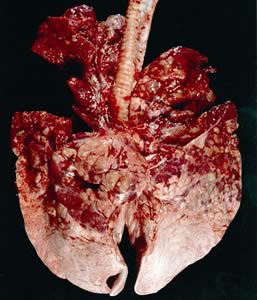 |
|||||||||
|
|||||||||||||||||||
|
|
Pneumonia Lung Damage Can Reduce Cattle
Growth Rates As the winter disease season approaches, vets are warning cattle producers that pneumonia-induced lung damage can severely compromise animal performance with the potential to reduce growth rates by up to 295g per day.
When faced with a pneumonia outbreak, producers should be looking for a disease treatment approach that delivers fast, visible recovery from the clinical symptoms of the disease, whilst also preserving lung function for future productivity. According to feedlot studies, it is often the pneumonia-induced lung damage that you can’t see that can really cripple enterprise profits. “Studies show that nearly 40% of the costs of pneumonia can be down to hidden growth performance penalties, which include any permanent lung damage effects,” cautions Schering-Plough Animal Health livestock veterinary adviser Andrew Montgomery MRCVS. “Lung damage develops fast when pneumonia strikes and once it occurs the damage can become permanent very quickly unless treatment is effective and rapid,” he warns. Andrew Montgomery points out that lungs are vital organs for life and for growth, but physiologically cattle are particularly prone to lung damage. “For cattle and horses of similar size, horse lungs are around 43% bigger than bovine ones. Consequently, cattle lungs have little spare capacity. And as a result of these physiological differences, inhaled air travels at a much faster speed into cattle lungs, enabling it to penetrate deep into the lungs. Unfortunately, when pneumonia strikes viruses and bacteria can quickly and easily follow the same direct route and once lungs become infected, the inflammation and bacterial toxins cause damage that can compromise future animal performance - even if the animal recovers from the disease,” he says. In preparation for the peak pneumonia season, Andrew Montgomery is urging farmers to talk to their vet about the latest advances in lung protection therapy. “Anti-inflammatory drug treatment alongside fast, effective and proven antibiotic therapy is now the gold standard pneumonia treatment protocol. Not only does it help prevent permanent lung damage, it also enables better delivery of the antibiotic to the infected areas of the lung. Inflammation causes blood vessels to constrict, but by keeping the bloodflow open with an anti-inflammatory, more of the antibiotic can reach the sites of bacterial infection to boost recovery rate - even if these sites are deep into the lungs,” he points out. “With headage payments gone farmers are now aiming to finish cattle younger and faster. They simply can’t afford the growth setbacks and lost productivity associated with pneumonia-induced permanent lung damage,” Andrew Montgomery stresses.
|
||||||||||||||||||

|
|
||||||||||||||||||
| home | agri-services | pedigree
pen | news | dairy | beef | machinery quota | property | organisations | site map |
|||||||||||||||||||
